If you're thinking about quitting lately, here are 25 reasons why you absolutely must take that step on World Health Day 2018


Representational Image
As per a study by Global Adult Tobacco Survey (GATS) the number of smokers in India has reduced by 81 lakh people compared to their first survey in 2010. This means that tobacco use has fallen by six percent over the past seven years. GATS a global survey that systematically monitors adult tobacco use by tracing key tobacco control indicators and its latest survey involved 74,037 people aged 15 and above across India between August 2016 and February 2017
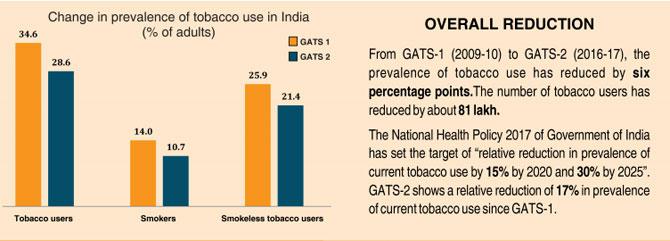
Image and statistics courtesy WHO and GATS 2 syrvey
The survey also found that India had gained by adding larger pictorial warnings on tobacco products, higher taxes and awareness campaigns. The study found that there has been a 33 percent reduction in use of tobacco amongst 15 to 24 year olds and a 54 per cent drop in people between 15 to 17 years of age.

Image and statistics courtesy WHO and GATS 2 survey
What’s more the study also found that Khaini, bidi and gutka are the most commonly used items among Indian men, while women primarily use betel quid with tobacco and khaini. The survey shows 19% of men, 2% of women and 10.7% of all adults currently smoke tobacco, while 29.6% of men, 12.8% of women and 21.4% of all adults use smokeless forms.
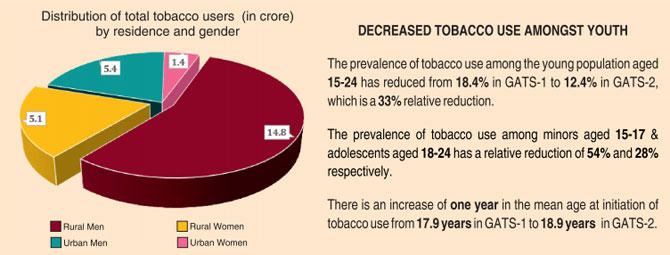
Image and statistics courtesy WHO and GATS 2 survey
Another significant finding was that the age that people started smoking had gone up by one year from 17.9 to 18.9 years of age.
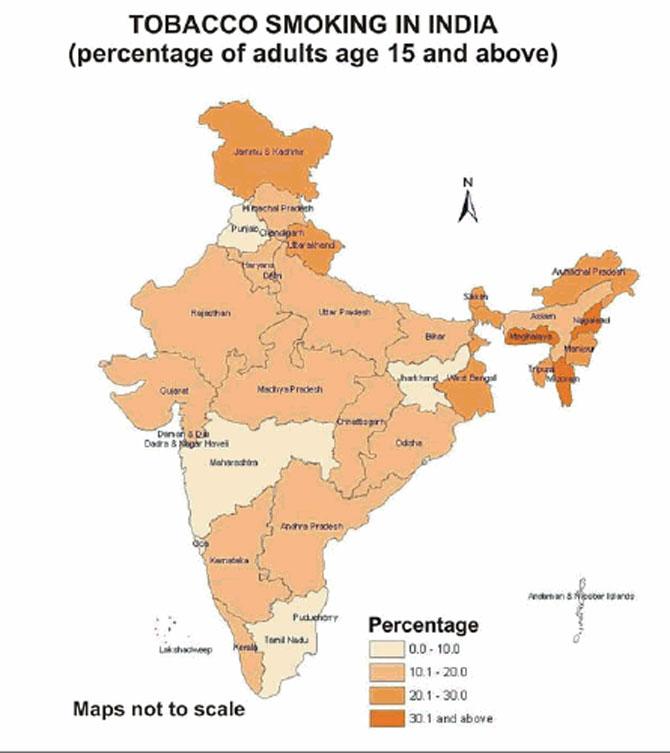
Image and statistics courtesy WHO and GATS 2 survey, Ministery of Health and Family welfare, Government of India
But while the stats may be compelling and show that the government initiatives have worked, smoking is something we all turn to when bored, stressed or simply craving a nicotine fix. But did you know that the cancer stick is a lot more than just that – it can lead to a host of other ailments that most of us don’t really know about. Wondering how? Here’s how smoking affects your health right from your first drag to when you exhale.
Also Read: Smoking Marijuana May Lead Non-Smokers To Cigarettes: Study
Your first drag: The most nocuous part of smoking, this is when the smoke enters your mouth and the fumes from the cigarette enter your mouth and damage the mucosal lining of your mouth and tongue. The heat from the cigarette affects the skin on your face mainly around your nose and mouth, causes your lips to darken, leads to wrinkles and the appearance of age spots. Another reason for the darkening of a smoker's lips is the fact that the tar in the cigarette tends to adhere to the lips, staining them.
Not to mention the constant pouting and sucking that one has to do in order to take a puff also leads to what is known as a smoker’s pout. A smoker’s pout is where there is an appearance of fine lines around the lips.
How cigarette smoke affects the inside of your mouth:
The most commonly visible effect of smoking is yellowing teeth which are caused due to tar coating the enamel of your teeth. The heat from the smoke also damages the cells in and around your mouth, and in some cases leading to a change in their DNA – causing mutations; and once inside the mouth the tar and other chemicals affect all parts of your oral cavity.
Further, the chemicals present in a cigarette coat your tongue, palate and the inside of your cheeks. It deadens your taste buds, hyperactivates your salivary glands and eventually blocks them, leading to a lack of saliva in your mouth.
Interesting fact! Noticed the fact that you need a drink of water after you’ve had a smoke? Well, the smoke you just had is to blame.
The tar and chemicals in a cigarette also coat the roof of your mouth, leading to a condition called the ‘smoker’s palate’ where the roof of your mouth gets coated with a whitish residue with small red spots protruding from it. These protrusions are actually the opening of ducts of glands present on the palate. What’s more, smoking also kills good bacteria in your mouth, giving way to bad breath and a condition called oral thrush.
Smoking also leads to gum disease, discolouration of the gums, leads to cavities and causes oral cancer. This is mainly because the heat combined with the chemicals in smoke tend to damage cells leading to mutations and change in their DNA. This change may affect either their mechanism of multiplying in a uniform manner or the one that stops their multiplication. It also affects your olfactory system (nose) leading to an eventual loss in your ability to smell.
Also Read: Quitting Smoking Gradually May Help Kick The Habit
When the smoke enters your throat:
Once you start to inhale the smoke, it first hits the back of your mouth or the top portion of your throat, packed with blood vessels the heat from the smoke causes them to immediately contract reducing blood flow to this area. It also affects the mucosal cells lining this part of your throat, eventually deadening them, leading to infections, excessive dryness and irritation at the back throat of your throat.
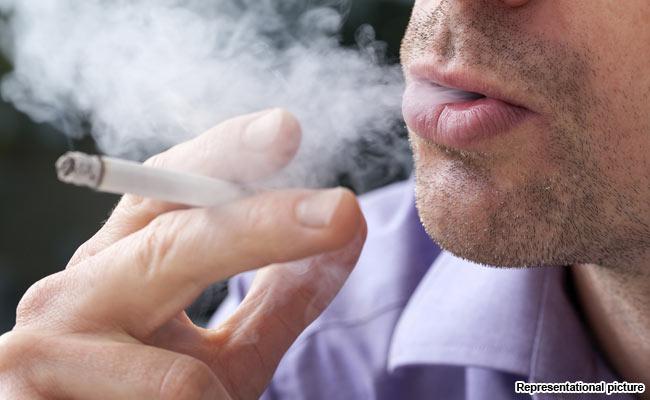
Interesting fact! One of the most common complaints most smokers have is that they feel an itchy sensation at the back of their mouth. This is due to the irritation and dryness of this region.
Once the smoke travels lower down into your throat it causes irritation that most experts say is due to the formaldehyde and acrolein abundantly present in cigarettes. Apart from that cigarette smoke also causes changes in one’s voice. Commonly seen as hoarseness of the voice, it is mainly because of the effect the chemicals have on the vocal chords. Smoking can also cause throat cancer due to constant irritation of the inner lining of the throat combined with the erosion and damage of the cells lining the throat.
When it enters your trachea or wind pipe:
The trachea is the pipe that leads to your lungs and is lined with tiny hair-like processes (called cilia) that help throw out any foreign objects. When you inhale smoke these delicate cilia get damaged which leads to itchiness in the trachea, causing a characteristic smokers cough.
It also affects your oesophagus:
Smoking affects your food pipe as well. The chemicals and heat from the smoke tend to affect your oesophageal sphincter muscle (the muscle responsible for keeping the contents and acids in your stomach from rising back up into your throat) . The weakening of this muscle is one of the main reasons for GERD (Gastro-oesophageal reflux disease), acidity, ulcers and other stomach ailments in smokers.
When it enters your bronchus and alveoli:
This where the cigarette smoke does the most damage, that is slow, progressive and deadly. Cigarette smoke attacks the cleaning mechanism of the respiratory system that is guided by cilia and mucous. In a smoker these cilia tend to get paralysed and eventually die; coupled with excessive mucous produced due to smoking and the body’s inability to get rid of the mucous leads to cough and mucous build up in one’s body. Apart from that the cells along the bronchioles get damaged and tend to multiply abnormally. These cells cause the hardening of the outer surface of the bronchioles and lead to lesser ability to exchange gas with the microscopic air sacs (called alveoli) present around them. Eventually, these air sacs burst and lead to what is known as emphysema. A common condition is seen in long-term smokers.
What's more, smoking also leads to a buildup of tar within the bronchioles. Which, when combined with thickening of the walls of one’s throat leads to breathlessness, wheezing, fatigue and in some cases dizziness. Cigarette smoke also contains carbon monoxide. This is a potentially lethal gas since it attaches to the haeme (iron) part of your blood and does not allow it to carry oxygen to other organs. Inhaling too much of this gas can kill you. In cigarette smoke carbon monoxide leads to lack of oxygen in the body, which eventually affects all your organs. It not only sets off the roller coaster of events leading to cancer it also starts the process of eventual decay of your organs — starting from your mouth to your brain, kidneys, liver, digestive system and blood.
Also Read: Over 50 Per Cent Teenagers Believe Smoking Cigarettes Cuts Stress: Survey
When you exhale:
It’s when you exhale that your body goes through the entire process again, but in reverse.
What it does to the rest of your body:
Number studies have found that smoking not only causes cancer, but also leads to cardiovascular disease, chronic kidney disease, poor vision, loss of bone density osteoarthritis, loss of teeth, joint pain and most importantly can leave one infertile.
As per Dr Arun Shah, Senior Nephrologist and Treasurer, Amar Gandhi Foundation, smoking has a snowball effect on one’s kidneys. He says, “When a person smokes it releases a number of chemicals in one’s blood and those chemicals affect every part of your body especially your kidneys. Cigarette smoke has heavy metals that leads to tubular dysfunction and atrophy. Moreover, when a person smokes he/she experiences hypoxia or lack of oxygen in their blood. This also leads to Tubular dysfunction and atrophy.” Apart from that smoking also leads to hypertension, intrarenal vasoconstriction, oxidative stress and a number of other ailments that all put together impact one’s kidneys leading to Chronic Kidney Disease (1)
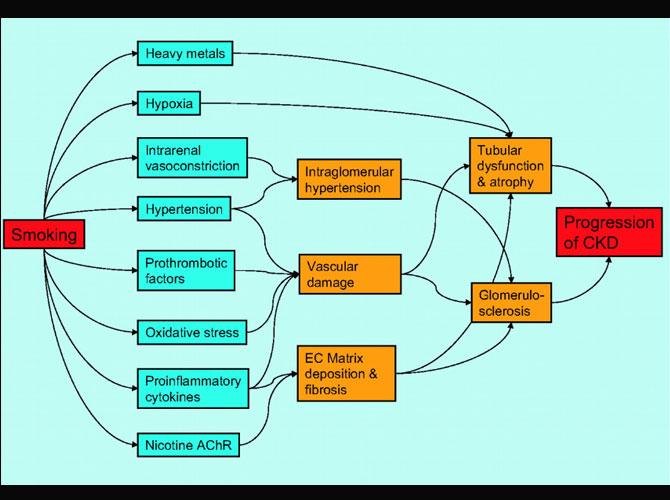
The pathway of chemicals and reactions that cigarette smoke takes to cause Chronic Kidney Disease. Image from Clinical Journal of the American Society of Nephrology
We asked Dr Rajalaxmi Walavalkar, Consultant, IVF and Reproductive Surgery, Cocoon Fertility about how smoking affects one’s fertility and she said, “The damage that smoking does to men is easily seen in their sperm count. Smokers tend to have lesser semen volume, sperm count and sperm motility also tends to be poorer. They also have a higher number of abnormal looking sperm in their samples and there is usually higher than normal DNA fragmentation in their sperm DNA.”
But does it depend on the number of cigarettes one smokes per day? Dr Walavalkar said, “The higher number of cigarettes you smoke, the worse your parameters become. That being said, any amount of smoking is bad; which means, whether you smoke one cigarette a day or are a regular passive smoker your body will show a degree of damage.”
“One thing people need to know is that cigarette smoke has nicotine mixed in with a large number of chemicals, and it’s those chemicals that are causing any kind of damage, is wrong. Even pure nicotine will have equally bad effects. So if you’re trying to quit because you want to preserve your fertility, then quit cold turkey because any kind of nicotine replacement therapy will affect your sperm count.” She added.
Another aspect that Dr Walavalkar mentioned was the fact that a smoker is likely to have 1/3rd the rate of live births at the end of an IVF cycle than a non-smoker. Dr Walavalkar said, “For every year you have smoked in your life, lowers the chances of getting pregnant reduce by 4 to 5 per cent per year(4).”
When asked about how smoking affects a woman, Dr Walavalkar said, "Ladies who smoke tend to have poorer egg quality, lesser changes of getting pregnant, higher miscarriage rates and tend to have babies that have intrauterine growth abnormalities(5). Most importantly, this is also true for those women who passive smoke. What’s more, passive smoke can also affect a woman’s unborn child and lead to lowered fertility in the baby as well.(7)"
So, the next time you light up that cigarette, think about what your body goes through to support your habit.
Also Read: One Cigarette Can Make Two-Thirds Of Adults Addicts: Study
Reference
(1) Smoking: A Risk Factor for Progression of Chronic Kidney Disease and for Cardiovascular Morbidity and Mortality in Renal Patients - Stephan R. Orth*, and Stein I. Hallan † CJASN January 2008 vol. 3 no. 1 226-236
(2) Association of Smoking with Cardiovascular and Infection-Related Morbidity and Mortality in Chronic Hemodialysis - Finnian R. Mc Causland, Steven M. Brunelli, and Sushrut S. Waikar
CJASN November 07, 2012 7): (11) 1827-1835; published ahead of print August 23, 2012, doi:10.2215/CJN.03880412
(3) Cigarette Smoking and the Association with Glomerular Hyperfiltration and Proteinuria in Healthy Middle-Aged Men - Isseki Maeda, Tomoshige Hayashi, Kyoko Kogawa Sato, Hideo Koh, Nobuko Harita, Yoshiko Nakamura, Ginji Endo, Hiroshi Kambe, and Kanji Fukuda
CJASN October 2011 6): (10) 2462-2469; published ahead of print September 1, 2011, doi:10.2215/CJN.00700111
(4) Evidence that male smoking affects the likelihood of a pregnancy following IVF treatment: application of the modified cumulative embryo score. - Joesbury KA1, Edirisinghe WR, Phillips MR, Yovich JL. Hum Reprod. 1998 Jun;13(6):1506-13.
(5) Impact of smoking on fertility and age of menopause: a population-based assessment - Oboni J, Marques-Vidal P, Bastardot F, et al - BMJ Open 2016;6:e012015. doi: 10.1136/bmjopen-2016-012015
(6) Effects of cigarette smoking on reproduction -- C. Dechanet T. Anahory J.C. Mathieu Daude X. Quantin L. Reyftmann S. HamamahB. Hedon H. Dechaud -- Human Reproduction Update, Volume 17, Issue 1, 1 January 2011, Pages 76–95
(7) Effects of maternal smoking on offspring reproductive outcomes: an intergenerational study
Sam Tweed Sohinee Bhattacharya Paul A. Fowler -- Human Reproduction Open, Volume 2017, Issue 2, 12 July 2017, hox006,
 Subscribe today by clicking the link and stay updated with the latest news!" Click here!
Subscribe today by clicking the link and stay updated with the latest news!" Click here!









